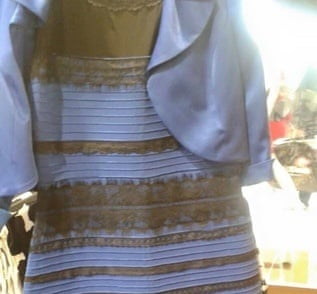

Do you remember this dress on social media? It was trending all over social media at some point in 2015. The major question that got everybody going was whether the dress was white and gold, or whether the dress was black and blue. What do you think? Take your time and look at the image for as long as you want. The internet was then made up by people firmly in two camps: the white and gold, and the blue and black – with each thinking the other is completely wrong. Believe it or not, at the time when it was trending, most people saw the dress as white and gold. But in actuality, the dress was black and blue.
So, do you want to go back and look at the dress? What do you think this time? Some people still see white and gold even after they are told that the dress is in actuality black and blue. You might still be seeing white and gold as well. It’s okay! You are not crazy or color-blind. But you may be wondering—why are you seeing white and gold when the dress is black and blue? The reason why you are most likely seeing the dress as white and gold has to do with the fact that there is some sort of bright light that is hitting the dress from the upper right side; and that combined with the particular contrast of the picture that has been circulating on the internet, you are seeing the light that is reflecting off of the blacks and the blues.
It’s all about perception—it’s about the evolution of human eyes and brains to sense color in a world with sunlight, as well as basic biology. Through the lens, light can enter the eye at different wavelengths, which correlate to distinct colors. When light strikes the retina at the back of the eye, pigments cause neural connections to fire, sending messages to the visual cortex in the brain, which translates them into an image. Critically, though, that first burst of light is made of whatever wavelengths are illuminating the world, reflecting off whatever you’re looking at. So when you look at the dress you first look at what is illuminating the dress; the bright light on the upper right side of the picture and then you look at the white light that is reflecting off of the black part of the dress. Additionally, you look at the gold light that is reflecting off of the blue part of the dress. Ultimately you end up seeing the dress as white and gold.
How about looking at the dress from this perspective? Check out the gif via the link below
https://media.wired.com/photos/59327b9ba3126458449954d1/master/w_1600,c_limit/bluedress-315-new.gif

Yes, both surfaces are grey. But how!? How come? The color we see is determined by more than just the light entering our eyes; it is also influenced by the inferences that led to that input. Our experiences with color are shaped by the context. Because of the way that individuals construct their experiences with color, some suffer more than others. Some people only see what is directly in front of them, while others are greatly impacted by the surrounding circumstances. When you look at the dress, what’s actually happening is that your eyes are either discounting the blue, causing you to see white and gold, or discounting the gold, causing you to see blue and black. But why would your eyes lie to you like this?
Human beings have adapted themselves to see in daylight, but daylight changes the color of everything we see. When viewing in daylight, human eyes attempt to compensate for chromatic bias. Light is reflected in order for us to see things. Light with various wavelengths that correspond to distinct colors enters the eye when we look at something. By subtracting that color from the actual color of the object, your brain determines what color light is reflecting off the surface your eyes are currently focused on.
In addition to capturing the attention of the internet in 2015, the dress paradox phenomenon provides significant insights into the fields of marketing, consumer psychology, and human perception. Fundamentally, the dress paradox emphasizes how context, experience, and contextual signals shape our perceptions and the complex interactions between reality and subjective interpretation.
The dress paradox serves as an excellent example of how context and framing play a crucial role in shaping customer behavior and decision-making from a marketing standpoint. Similar to how background and lighting may alter how a dress appears to be colored, marketers can intentionally create narratives, images, and experiences to influence how customers view their brands and products. Through a comprehension of the psychological processes that underlie perceptual illusions, marketers can effectively utilize context to amplify brand allure, elicit sentimental reactions, and stimulate customer involvement.
The dress paradox also provides insight into the intricacies of human perception and cognition by illuminating the ways in which our brains integrate sensory data and create reality. As consumers, we often find that our views are shaped by a variety of factors, such as cognitive biases, cultural norms, and prior experiences, rather than by objective reality. Businesses can create goods, services, and advertising campaigns that appeal to a variety of audience segments and take into account their distinct tastes and viewpoints by recognizing the subjectivity of perception.
Essentially, the dress paradox is a powerful reminder of the complexities of human perception and the influence of context on how we perceive the environment. In a market that is becoming more and more competitive, organizations can seize new opportunities for innovation, differentiation, and customer engagement by embracing ambiguity, utilizing context, and mastering the subtleties of perception.